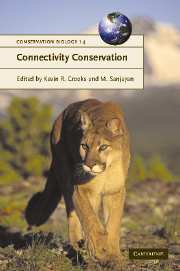Book contents
- Frontmatter
- Contents
- List of contributors
- Acknowledgements
- 1 Connectivity conservation: maintaining connections for nature
- PART I Approaches to connectivity research
- PART II Assessing connectivity
- Introduction: evaluating and quantifying the conservation dividends of connectivity
- 12 Quantifying connectivity: balancing metric performance with data requirements
- 13 Assessing connectivity in salmonid fishes with DNA microsatellite markers
- 14 Individual-based modeling as a tool for conserving connectivity
- 15 Linking connectivity to viability: insights from spatially explicit population models of large carnivores
- 16 Impacts of corridors on populations and communities
- 17 Exploring the functional connectivity of landscapes using landscape networks
- PART III Challenges and implementation of connectivity conservation
- Index
- References
16 - Impacts of corridors on populations and communities
Published online by Cambridge University Press: 24 May 2010
- Frontmatter
- Contents
- List of contributors
- Acknowledgements
- 1 Connectivity conservation: maintaining connections for nature
- PART I Approaches to connectivity research
- PART II Assessing connectivity
- Introduction: evaluating and quantifying the conservation dividends of connectivity
- 12 Quantifying connectivity: balancing metric performance with data requirements
- 13 Assessing connectivity in salmonid fishes with DNA microsatellite markers
- 14 Individual-based modeling as a tool for conserving connectivity
- 15 Linking connectivity to viability: insights from spatially explicit population models of large carnivores
- 16 Impacts of corridors on populations and communities
- 17 Exploring the functional connectivity of landscapes using landscape networks
- PART III Challenges and implementation of connectivity conservation
- Index
- References
Summary
INTRODUCTION
This chapter focuses specifically on the most popular approach to maintain connectivity in conservation and management, which is to create or maintain habitat corridors. The popularity of corridors in conservation derives from the direct and intuitive relationship to their purported function: by physically connecting otherwise isolated fragments, corridors should increase the movement of both individuals and genes. In doing so, corridors provide sources of immigrants to offset local extinction, and sources of genetic diversity to reduce harmful effects of inbreeding and drift. The most fundamental spatial models in ecology, including island biogeographic models (MacArthur and Wilson 1967) and metapopulation models (Levins 1969; Hanski 1999), predict that movement between patches will increase population size and persistence and, through the rescue of declining populations (Brown and Kodric-Brown 1977), maintain local species richness. We recognize that studies focusing on corridors represent only a small fraction of studies on connectivity, and the large literature examining effects of patch isolation on colonization and occupancy in metapopulations has been reviewed elsewhere (see Table 9.1 in Hanski 1999; Moilanen and Nieminen 2002; Molainen and Hanski Chapter 3). The goal of this chapter is to assess existing evidence for corridor effects on populations and communities, and to discuss future directions that would permit more rigorous evaluation of their use in conservation.
We focus on population and community impacts of corridors because evidence for the necessary prerequisite – that corridors increase movement and gene flow – has been growing and has also been reviewed elsewhere.
- Type
- Chapter
- Information
- Connectivity Conservation , pp. 390 - 415Publisher: Cambridge University PressPrint publication year: 2006
References
- 22
- Cited by



